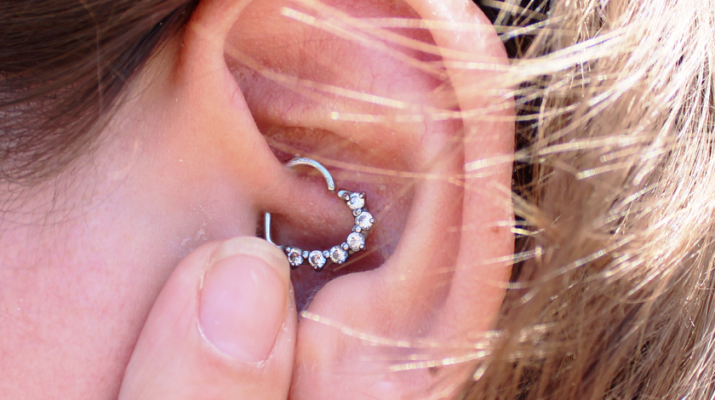By Deborah Jeanne Sergeant
 Most people obtain body piercings because they like the style; however, a few seek a specific piercing because it’s believed to help reduce the symptoms of migraine headaches.
Most people obtain body piercings because they like the style; however, a few seek a specific piercing because it’s believed to help reduce the symptoms of migraine headaches.
Anecdotally, piercing the daith (some pronounce it to rhyme with “goth”; others rhyme it with “faith”) is said to lessen the pain, nausea, light sensitivity and other migraine symptoms. Those who use it claim that piercing the ear in its innermost fold of cartilage just above the ear canal turns off migraine pain in a similar way to acupuncture.
Marc McDade, a doctor of chiropractic practicing in Rochester, said that many migraines “find their root in the upper neck. The brain stem initiates the migraine sequence.”
Though he has heard of acupuncture as helpful for migraine sufferers, he hasn’t heard of any research on daith piercings.
Research into daith piercings would likely be difficult because so many different factors can affect migraine headaches.
Steven Sadlon, doctor of chiropractic, licensed acupuncturist and owner of Chiropractic Health and Acupuncture in Rochester, said that body piercings interrupt meridian flow.
“In acupuncture, we use specific pathways,” he said. “When you puncture that point in the ear, you put the body into override and that point can never really be turned off. It may stop working and create problems. I don’t think daith piercing is a good idea in the long term.”
Although he said that some people seem to find relief through daith piercing, other factors involved can make the piercing ineffective for many people.
“Even in Western medicine, migraines are broken up into 11 categories and 20 in Chinese medicine,” Sadlon said. “You have to give people an exam and diagnosis before starting treatment to get to the root of the problem.”
He added that many people feel frustrated waiting weeks for their medical doctor to see them and want to try something different, such as daith piercing, when they can’t get relief.
People performing the piercing most likely have no training in treating migraines or in acupuncture. Desiree Sale, licensed acupuncturist at NeuroloQi Acupuncture in Rochester, said that acupuncture treatment for migraines varies by what’s causing them, so stating that one piercing can solve all migraines oversimplifies the issue.
“There’s no one point — certainly not in the ear — to treat migraines, just routine types of headaches,” Sale said. “I’d go over the signs and symptoms before I’d do treatment. There are several maps of ear acupuncture. With the map I use, I don’t use that point on the ear.”
She tends to initially stay away from the ear until she knows how patients respond to other acupuncture points. Some people respond poorly to acupuncture on the ear.
Sale said that for the past several years, more and more clients have asked about daith piercing for migraine relief. One person tried it; however, she said it did nothing for her migraines.
Before obtaining a daith piercing, it’s also important to realize how different it is from standard earlobe piercing. Many shopping mall jewelry stores perform only lobe piercing because of its low rate of infection and other complications but refuse to pierce cartilage because it’s more complicated–and painful. People seeking a daith piercing must go to a stand-alone piercing business.
The daith piercing is tricky to keep clean because for many people, their hair touches the piercing more often and because it’s tucked into the innermost crease of the ear. The position also makes turning the piercing stud difficult. Should the daith piercing not help reduce migraine pain, the earring may be removed to allow the piercing to close; however, it will likely leave a scar.
Before undertaking a daith piercing, discuss the possibility of complications with a health care provider.

